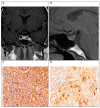Plurihormonal Pituitary Neuroendocrine Tumors: Clinical Relevance of Immunohistochemical Analysis
- PMID: 38248047
- PMCID: PMC10814282
- DOI: 10.3390/diagnostics14020170
Plurihormonal Pituitary Neuroendocrine Tumors: Clinical Relevance of Immunohistochemical Analysis
Abstract
Plurihormonal pituitary neuroendocrine tumors (PitNETs) are rare forms of tumors that express more than one hormone. The most common association is between growth hormone (GH) and prolactin (PRL), but other unusual combinations have been reported, such as GH and ACTH. Usually, the clinical dominance in these cases is related to GH hypersecretion. In these cases, immunohistochemistry (IHC) of transcription factors (TFs) is very useful for an accurate diagnosis. We included 42 patients diagnosed with pituitary neuroendocrine tumors (PitNETs): 37 patients with a confirmed diagnosis of acromegaly, and 5 patients with prolactinomas. All patients underwent transsphenoidal surgical intervention. We correlated the immunohistochemical features of plurihormonal PitNETs with clinical, hormonal, and imaging data. Tumor specimens were histologically and immunohistochemically examined. Based on the 2022 WHO classification, using IHC, 13 patients exhibited positive staining for more than one hormone, while unusual combinations like GH + ACTH and PRL + ACTH were also identified in other cases. Unusual cell combinations that produce hormones unrelated histogenetically, biochemically, or through regulatory mechanisms can appear and may display aggressive behavior, persistent disease, and high recurrence. We have not identified a clear correlation with the prognosis of these rare PitNETs.
Keywords: Cushing’s disease; acromegaly; immunohistochemistry; pituitary transcription factors; plurihormonal pituitary neuroendocrine tumors.
Conflict of interest statement
The authors declare no conflicts of interest.
Figures




Similar articles
-
Multilineage Pituitary Neuroendocrine Tumors (PitNETs) Expressing PIT1 and SF1.Endocr Pathol. 2023 Sep;34(3):273-278. doi: 10.1007/s12022-023-09777-x. Epub 2023 Jun 2. Endocr Pathol. 2023. PMID: 37268858
-
Multilineage Pituitary Neuroendocrine Tumors Expressing TPIT and SF1: A Clinicopathological Series of Six Tumors.Endocr Pathol. 2024 Dec;35(4):349-353. doi: 10.1007/s12022-024-09841-0. Epub 2024 Nov 23. Endocr Pathol. 2024. PMID: 39579326
-
The Value of ER∝ in the Prognosis of GH- and PRL-Secreting PitNETs: Clinicopathological Correlations.Int J Mol Sci. 2023 Nov 10;24(22):16162. doi: 10.3390/ijms242216162. Int J Mol Sci. 2023. PMID: 38003353 Free PMC article.
-
Pleiomorphism plurihormonal Pit-1-positive macroadenoma with central hyperthyroidism: a rare case report and literature review.BMC Endocr Disord. 2022 Dec 21;22(1):325. doi: 10.1186/s12902-022-01220-2. BMC Endocr Disord. 2022. PMID: 36539773 Free PMC article. Review.
-
An Update on Pituitary Neuroendocrine Tumors Leading to Acromegaly and Gigantism.J Clin Med. 2021 May 22;10(11):2254. doi: 10.3390/jcm10112254. J Clin Med. 2021. PMID: 34067494 Free PMC article. Review.
References
-
- Wei L., Yue Z., Wang S. Immunopathological study of plurihormonal pituitary adenomas. Chin. J. Neurosurg. 2008;13:208.
LinkOut - more resources
Full Text Sources

